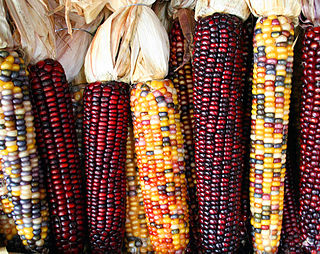
Zea is a genus of flowering plants in the grass family. The best-known species is Z. mays, one of the most important crops for human societies throughout much of the world. The four wild species are commonly known as teosintes and are native to Mesoamerica.

Eriocoma hymenoides is a cool-season, perennial bunchgrass. It is native to western North America.
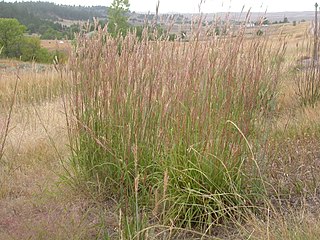
Andropogon gerardi, commonly known as big bluestem, is a species of tall grass native to much of the Great Plains and grassland regions of central and eastern North America. It is also known as tall bluestem, bluejoint, and turkeyfoot.

Setosphaeria turcica is the causal agent of northern corn leaf blight in maize. It is a serious fungal disease prevalent in cooler climates and tropical highlands wherever corn is grown. It is characterized by large cigar shaped necrotic lesions that develop on the leaves due to the polyketide metabolite monocerin.

Maize, also known as corn in North American English, is a tall stout grass that produces cereal grain. It was domesticated by indigenous peoples in southern Mexico about 9,000 years ago from wild teosinte. Native Americans planted it alongside beans and squashes in the Three Sisters polyculture. The leafy stalk of the plant gives rise to male inflorescences or tassels which produce pollen, and female inflorescences called ears. The ears yield grain, known as kernels or seeds. In modern commercial varieties, these are usually yellow or white; other varieties can be of many colors.

Tripsacum dactyloides, commonly called eastern gamagrass, or Fakahatchee grass, is a warm-season, sod-forming bunch grass. It is widespread in the Western Hemisphere, native from the eastern United States to northern South America. Its natural habitat is in sunny moist areas, such as along watercourses and in wet prairies. In some areas, it has adapted well to disturbed conditions.

Puccinellia distans is a species of grass known by the common names weeping alkaligrass and European alkali grass. It is native to Europe and it is present in most of North America, where it is perhaps an introduced species. It grows in moist habitat, usually in areas with saline soils, such as the edges of salted roads. It is a perennial herb producing hollow stems up to 40 to 60 centimeters in maximum height. The inflorescence is a spreading array of branches, the lower ones reflexed. The branches bear several rough-haired spikelets containing flowers.

Setaria verticillata is a species of grass known by the common names hooked bristlegrass, rough bristle-grass and bristly foxtail. It is native to Europe, but it is known on most continents as an introduced species and often a noxious weed. It is a hardy bunchgrass which grows in many types of urban, cultivated, and disturbed habitat. It is a weed of many types of agricultural crops, growing in vineyards and fields. Herbicide-resistant strains have been noted.

Urena lobata, commonly known as Caesarweed or Congo jute, is a tender perennial, variable, erect, ascendant shrub or subshrub measuring up to 0.5 meters (1.6 ft) to 2.5 meters (8.2 ft) tall. The stems are covered with minute, star-like hairs and often tinged purple. Considered a weed, it is considered to be native throughout much of the tropical and subtropical world, including South and Central America, Africa, Asia and Pacific Islands.
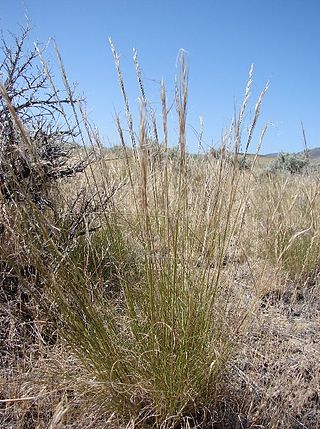
Eriocoma thurberiana is a species of grass known by the common name Thurber's needlegrass. It is native to the western United States, where it occurs from Washington to California and east to Montana and Wyoming.

Panicum repens is a species of grass known by many common names, including torpedo grass, creeping panic, panic rampant, couch panicum, wainaku grass, quack grass, dog-tooth grass, and bullet grass. Its exact native range is obscure. Sources suggest that the grass is native to "Africa and/or Asia", "Europe or Australia", "Eurasia", "Australia", "Europe, Asia, and Africa", or other specific regions, including the Mediterranean, Israel, and Argentina. It is present in many places as an introduced species and often a noxious weed. It has been called "one of the world's worst weeds."
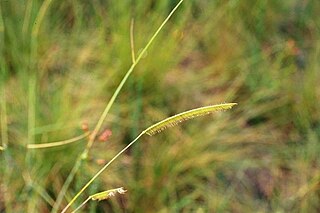
Ctenium aromaticum is a species of grass known by the common name toothache grass. It is native to the southeastern United States, where it grows on the coastal plain.

Paspalum floridanum is a species of grass known by the common name Florida paspalum. It is native to the eastern United States.

Paspalum vaginatum is a species of grass known by many names, including seashore paspalum, biscuit grass, saltwater couch, silt grass, and swamp couch. It is native to the Americas, where it grows in tropical and subtropical regions. It is found throughout the other tropical areas of the world, where it is an introduced species and sometimes an invasive weed. It is also cultivated as a turfgrass in many places.
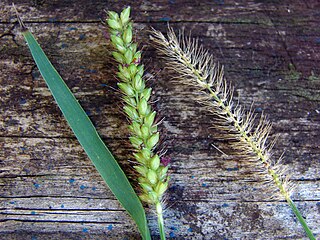
Setaria parviflora is a species of grass known by the common names marsh bristlegrass, knotroot bristle-grass, bristly foxtail and yellow bristlegrass. It is native to North America, including Mexico and the United States from California to the East Coast, Central America and the West Indies, and South America.

Setaria palmifolia is a species of grass known by the common names palmgrass, highland pitpit, hailans pitpit, short pitpit, broadleaved bristlegrass, and knotroot. It is native to temperate and tropical Asia. It is known elsewhere as an introduced, and often invasive, species, including in Australia, New Zealand, many Pacific Islands, and the Americas.

Alysicarpus vaginalis is a species of flowering plant in the legume family, Fabaceae. It is native to parts of Africa and Asia, and it has been introduced to other continents, such as Australia and the Americas. It is cultivated as a fodder for livestock, for erosion control, and as a green manure. Common names include alyce clover, buffalo clover, buffalo-bur, one-leaf clover, and white moneywort.

Digitaria ciliaris is a species of grass known by the common names southern crabgrass, tropical finger-grass, tropical crabgrass or summer grass.

Urochloa mutica, commonly known as para grass, buffalo grass, Mauritius signal grass, pasto pare, malojilla, gramalote, parana, Carib grass, and Scotch grass, is a species of grass. Despite its common name of California grass, it does not occur in California; it is native to northern and central Africa and parts of the Middle East, where it is cultivated for fodder. It was introduced elsewhere and it is now cultivated throughout tropical regions of the world for this purpose.

Northern corn leaf blight (NCLB) or Turcicum leaf blight (TLB) is a foliar disease of corn (maize) caused by Exserohilum turcicum, the anamorph of the ascomycete Setosphaeria turcica. With its characteristic cigar-shaped lesions, this disease can cause significant yield loss in susceptible corn hybrids.




















